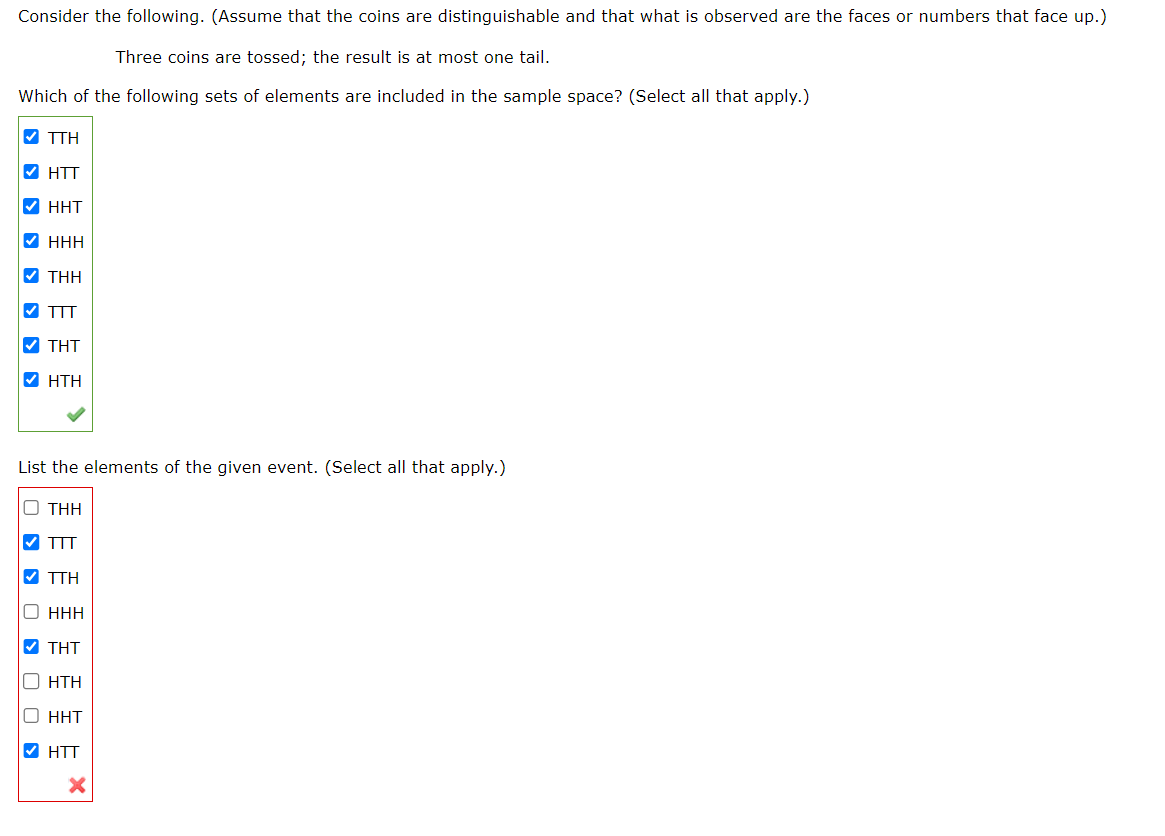Consider the following. (Assume that what is observed are the numbers that face up.) HINT [See Examples 1-3.] Two indistinguishable dice are rolled; the numbers add to 6. Describe the sample space S of the experiment. (Select all that apply.) O (5,5) (5,6) O (2,2) (2,3) (2,4) (2,5) (2,6) O (5,5) (5,6) (5,7) (4,4) (4,5) (4,6) (4,7) □ (6,6) (1,1) (1,2) (1,3) (1,4) (1,5) (1,6) (1,7) O (7,7) (3,3) (3,4) (3,5) (3,6) (3,7) O (1,1) (1,2) (1,3) (1,4) (1,5) (1,6) □ (6,6) (6,7) O (4,4) (4,5) (4,6) (2,2) (2,3) (2,4) (2,5) (2,6) (2,7) (3,3) (3,4) (3,5) (3,6) List the elements of the given event. (Select all that apply.) (4,4) (3,5) (2,6) (3,3) (2,4) (1,5) O (4,5) (3,6) (3,4) (2,5) (1,6) □ (6,6) O (5,5) (5,6) O (1,2) (3,3) (2,4) (4,2) (1,5) (5,1)
Consider the following. (Assume that what is observed are the numbers that face up.) HINT [See Examples 1-3.] Two indistinguishable dice are rolled; the numbers add to 6. Describe the sample space S of the experiment. (Select all that apply.) O (5,5) (5,6) O (2,2) (2,3) (2,4) (2,5) (2,6) O (5,5) (5,6) (5,7) (4,4) (4,5) (4,6) (4,7) □ (6,6) (1,1) (1,2) (1,3) (1,4) (1,5) (1,6) (1,7) O (7,7) (3,3) (3,4) (3,5) (3,6) (3,7) O (1,1) (1,2) (1,3) (1,4) (1,5) (1,6) □ (6,6) (6,7) O (4,4) (4,5) (4,6) (2,2) (2,3) (2,4) (2,5) (2,6) (2,7) (3,3) (3,4) (3,5) (3,6) List the elements of the given event. (Select all that apply.) (4,4) (3,5) (2,6) (3,3) (2,4) (1,5) O (4,5) (3,6) (3,4) (2,5) (1,6) □ (6,6) O (5,5) (5,6) O (1,2) (3,3) (2,4) (4,2) (1,5) (5,1)
A First Course in Probability (10th Edition)
10th Edition
ISBN:9780134753119
Author:Sheldon Ross
Publisher:Sheldon Ross
Chapter1: Combinatorial Analysis
Section: Chapter Questions
Problem 1.1P: a. How many different 7-place license plates are possible if the first 2 places are for letters and...
Related questions
Question
![Consider the following. (Assume that what is observed are the numbers that face up.) HINT [See Examples 1-3.]
Two indistinguishable dice are rolled; the numbers add to 6.
Describe the sample space S of the experiment. (Select all that apply.)
O (5,5) (5,6)
O (2,2) (2,3) (2,4) (2,5) (2,6)
O (5,5) (5,6) (5,7)
(4,4) (4,5) (4,6) (4,7)
□ (6,6)
(1,1) (1,2) (1,3) (1,4) (1,5) (1,6) (1,7)
O (7,7)
(3,3) (3,4) (3,5) (3,6) (3,7)
O (1,1) (1,2) (1,3) (1,4) (1,5) (1,6)
□ (6,6) (6,7)
O (4,4) (4,5) (4,6)
(2,2) (2,3) (2,4) (2,5) (2,6) (2,7)
(3,3) (3,4) (3,5) (3,6)
List the elements of the given event. (Select all that apply.)
(4,4) (3,5) (2,6)
(3,3) (2,4) (1,5)
O (4,5) (3,6)
(3,4) (2,5) (1,6)
□ (6,6)
O (5,5) (5,6)
O (1,2)
(3,3) (2,4) (4,2) (1,5) (5,1)](/v2/_next/image?url=https%3A%2F%2Fcontent.bartleby.com%2Fqna-images%2Fquestion%2Fbce6a0cf-373b-4a7a-ae65-e94348138195%2F88b14f6e-37bb-4ce1-ae2b-4c4cfc19ba4c%2Fraw32zd_processed.png&w=3840&q=75)
Transcribed Image Text:Consider the following. (Assume that what is observed are the numbers that face up.) HINT [See Examples 1-3.]
Two indistinguishable dice are rolled; the numbers add to 6.
Describe the sample space S of the experiment. (Select all that apply.)
O (5,5) (5,6)
O (2,2) (2,3) (2,4) (2,5) (2,6)
O (5,5) (5,6) (5,7)
(4,4) (4,5) (4,6) (4,7)
□ (6,6)
(1,1) (1,2) (1,3) (1,4) (1,5) (1,6) (1,7)
O (7,7)
(3,3) (3,4) (3,5) (3,6) (3,7)
O (1,1) (1,2) (1,3) (1,4) (1,5) (1,6)
□ (6,6) (6,7)
O (4,4) (4,5) (4,6)
(2,2) (2,3) (2,4) (2,5) (2,6) (2,7)
(3,3) (3,4) (3,5) (3,6)
List the elements of the given event. (Select all that apply.)
(4,4) (3,5) (2,6)
(3,3) (2,4) (1,5)
O (4,5) (3,6)
(3,4) (2,5) (1,6)
□ (6,6)
O (5,5) (5,6)
O (1,2)
(3,3) (2,4) (4,2) (1,5) (5,1)

Transcribed Image Text:Consider the following. (Assume that the coins are distinguishable and that what is observed are the faces or numbers that face up.)
Three coins are tossed; the result is at most one tail.
Which of the following sets of elements are included in the sample space? (Select all that apply.)
✔TTH
✔HTT
✔ HHT
✔HHH
✔THH
✔TTT
✔THT
✔HTH
List the elements of the given event. (Select all that apply.)
D THH
✔TTT
✔TTH
OHHH
✔THT
O HTH
O HHT
✔HTT
Expert Solution
This question has been solved!
Explore an expertly crafted, step-by-step solution for a thorough understanding of key concepts.
This is a popular solution!
Trending now
This is a popular solution!
Step by step
Solved in 2 steps with 2 images

Recommended textbooks for you

A First Course in Probability (10th Edition)
Probability
ISBN:
9780134753119
Author:
Sheldon Ross
Publisher:
PEARSON


A First Course in Probability (10th Edition)
Probability
ISBN:
9780134753119
Author:
Sheldon Ross
Publisher:
PEARSON
